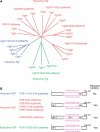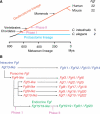Fibroblast growth factors: from molecular evolution to roles in development, metabolism and disease
- PMID: 20940169
- PMCID: PMC3106964
- DOI: 10.1093/jb/mvq121
Fibroblast growth factors: from molecular evolution to roles in development, metabolism and disease
Abstract
Fibroblast growth factors (FGFs) are a family of structurally related polypeptides that are essential for embryonic development and that function postnatally as homoeostatic factors, in the response to injury, in the regulation of electrical excitability of cells and as hormones that regulate metabolism. In humans, FGF signalling is involved in developmental, neoplastic, metabolic and neurological diseases. Fgfs have been identified in metazoans but not in unicellular organisms. In vertebrates, FGFs can be classified as having intracrine, paracrine and endocrine functions. Paracrine and endocrine FGFs act via cell-surface FGF receptors (FGFRs); while, intracrine FGFs act independent of FGFRs. The evolutionary history of the Fgf family indicates that an intracrine Fgf is the likely ancestor of the Fgf family. During metazoan evolution, the Fgf family expanded in two phases, after the separation of protostomes and deuterostomes and in the evolution of early vertebrates. These expansions enabled FGFs to acquire diverse actions and functions.
Figures


Similar articles
-
Hormone-like (endocrine) Fgfs: their evolutionary history and roles in development, metabolism, and disease.Cell Tissue Res. 2010 Oct;342(1):1-11. doi: 10.1007/s00441-010-1024-2. Epub 2010 Aug 24. Cell Tissue Res. 2010. PMID: 20730630 Free PMC article. Review.
-
The Saga of Endocrine FGFs.Cells. 2021 Sep 14;10(9):2418. doi: 10.3390/cells10092418. Cells. 2021. PMID: 34572066 Free PMC article. Review.
-
Evolution of the Fgf and Fgfr gene families.Trends Genet. 2004 Nov;20(11):563-9. doi: 10.1016/j.tig.2004.08.007. Trends Genet. 2004. PMID: 15475116 Review.
-
FGF signaling emerged concomitantly with the origin of Eumetazoans.Mol Biol Evol. 2014 Feb;31(2):310-8. doi: 10.1093/molbev/mst222. Epub 2013 Nov 12. Mol Biol Evol. 2014. PMID: 24222650
-
The Fgf families in humans, mice, and zebrafish: their evolutional processes and roles in development, metabolism, and disease.Biol Pharm Bull. 2007 Oct;30(10):1819-25. doi: 10.1248/bpb.30.1819. Biol Pharm Bull. 2007. PMID: 17917244 Review.
Cited by
-
Exploring mechanisms of FGF signalling through the lens of structural biology.Nat Rev Mol Cell Biol. 2013 Mar;14(3):166-80. doi: 10.1038/nrm3528. Epub 2013 Feb 13. Nat Rev Mol Cell Biol. 2013. PMID: 23403721 Free PMC article. Review.
-
Mechanisms of Fibroblast Growth Factor 21 Adsorption on Macroion Layers: Molecular Dynamics Modeling and Kinetic Measurements.Biomolecules. 2023 Nov 26;13(12):1709. doi: 10.3390/biom13121709. Biomolecules. 2023. PMID: 38136581 Free PMC article.
-
Fibroblast growth factor-21 enhances mitochondrial functions and increases the activity of PGC-1α in human dopaminergic neurons via Sirtuin-1.Springerplus. 2014 Jan 2;3:2. doi: 10.1186/2193-1801-3-2. eCollection 2014. Springerplus. 2014. PMID: 25932355 Free PMC article.
-
Fibroblast growth factor-9 enhances M2 macrophage differentiation and attenuates adverse cardiac remodeling in the infarcted diabetic heart.PLoS One. 2015 Mar 13;10(3):e0120739. doi: 10.1371/journal.pone.0120739. eCollection 2015. PLoS One. 2015. PMID: 25768089 Free PMC article.
-
Gain-of-function FHF1 mutation causes early-onset epileptic encephalopathy with cerebellar atrophy.Neurology. 2016 Jun 7;86(23):2162-70. doi: 10.1212/WNL.0000000000002752. Epub 2016 May 4. Neurology. 2016. PMID: 27164707 Free PMC article.
References
-
- Itoh N., Ornitz D.M. Functional evolutionary history of the mouse Fgf gene family. Dev. Dyn. 2008;237:18–27. - PubMed
-
- Kharitonenkov A. FGFs and metabolism. Curr. Opin. Pharmacol. 2009;9:805–810. - PubMed
-
- Goldfarb M., Schoorlemmer J., Williams A., Diwakar S., Wang Q., Huang X., Giza J., Tchetchik D., Kelley K., Vega A., Matthews G., Rossi P., Ornitz D.M., D’Angelo E. Fibroblast growth factor homologous factors control neuronal excitability through modulation of voltage-gated sodium channels. Neuron. 2007;55:449–463. - PMC - PubMed
Publication types
MeSH terms
Substances
Grants and funding
LinkOut - more resources
Full Text Sources
Other Literature Sources

